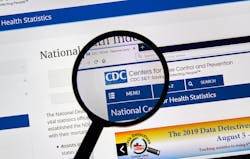More than 80 percent of pregnancy-related deaths were preventable, according to a Centers for Disease Control and Prevention report based on 2017-2019 data from Maternal Mortality Review Committees (MMRCs), which review the circumstances around pregnancy-related deaths to identify recommendations to prevent future deaths.
MMRCs shared data with CDC on 1,018 pregnancy-related deaths among residents of 36 states from 2017–2019. Information from MMRCs on leading causes of death by race and ethnicity can be used to prioritize interventions that can save lives and reduce health disparities.
“The report paints a much clearer picture of pregnancy-related deaths in this country,” said Wanda Barfield, M.D., M.P.H., director of CDC’s Division of Reproductive Health at the National Center for Chronic Disease Prevention and Health Promotion, in a statement. “The majority of pregnancy-related deaths were preventable, highlighting the need for quality improvement initiatives in states, hospitals, and communities that ensure all people who are pregnant or postpartum get the right care at the right time.”
Among pregnancy-related deaths with information on timing, 22 percent of deaths occurred during pregnancy, 25 percent occurred on the day of delivery or within 7 days after, and 53 percent occurred between 7 days to 1 year after pregnancy.
The leading underlying causes of pregnancy-related death include:
- Mental health conditions (including deaths to suicide and overdose/poisoning related to substance use disorder) (23 percent)
- Excessive bleeding (hemorrhage) (14 percent)
- Cardiac and coronary conditions (relating to the heart) (13 percent)
- Infection (9 percent)
- Thrombotic embolism (a type of blood clot) (9 percent)
- Cardiomyopathy (a disease of the heart muscle) (9 percent)
- Hypertensive disorders of pregnancy (relating to high blood pressure) (7 percent)
The leading underlying cause of death varied by race and ethnicity. Cardiac and coronary conditions were the leading underlying cause of pregnancy-related deaths among non-Hispanic Black people; mental health conditions were the leading underlying cause for Hispanic and non-Hispanic White people; and hemorrhage was the leading underlying cause for non-Hispanic Asian people.
American Indian or Alaska Native (AI/AN) people are disproportionally impacted by pregnancy-related deaths. A second report uses an approach for classifying AI/AN populations that includes those who also identify as multi-racial or of Hispanic ethnicity.
Based on a review of pregnancy-related deaths among AI/AN people, mental health conditions and hemorrhage were the most common underlying causes of death, accounting for 50 percent of deaths with a known underlying cause. Most pregnancy-related deaths of AI/AN people (93 percent) were determined to be preventable. About 64 percent of deaths occurred between 7 days to 1 year after pregnancy.
More than half (53 percent) of pregnancy-related deaths happen up to one year after delivery. The CDC says it is critical for all healthcare professionals to ask whether their patient is pregnant or has been pregnant in the last year to inform diagnosis and treatment decisions. Healthcare systems, communities, families, and other support systems need to be aware of the serious pregnancy-related complications that can happen during and after pregnancy.
Examples of prevention recommendations from MMRCs include wider access to insurance coverage to improve prenatal care initiation and follow-up after pregnancy, providing opportunities to prevent barriers to transportation to care, and the need for systems of referral and coordination.
Recently, CDC expanded its investment in efforts to eliminate preventable pregnancy-related deaths, with new awards totaling $2.8 million to support additional MMRCs in nine jurisdictions. CDC now supports MMRCs in 39 states and one U.S. Territory.
Angela Aina, co-founding executive director of the Black Mamas Matter Alliance, issued a statement about the report, noting that “BMMA is supportive of the improved reporting from MMRCs, which has captured that an increased majority of maternal deaths are preventable. This supports the fact that we need to continue to focus on being solutions-oriented and addressing systemic healthcare delivery failures. Addressing inequities in maternal health, especially for Black birthing people who are disproportionately impacted, requires governmental accountability with resource distribution and ensuring access to quality care that is holistic and culturally congruent.”


